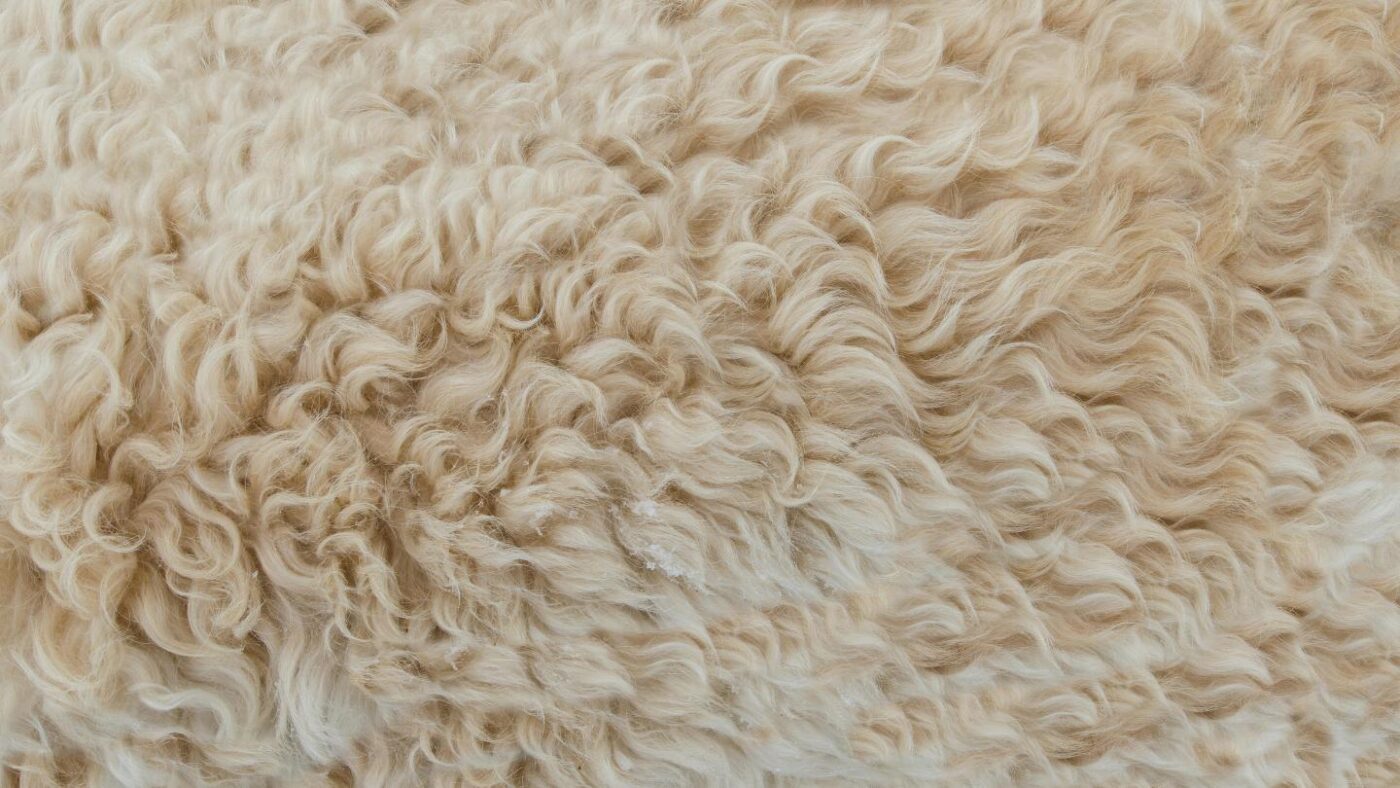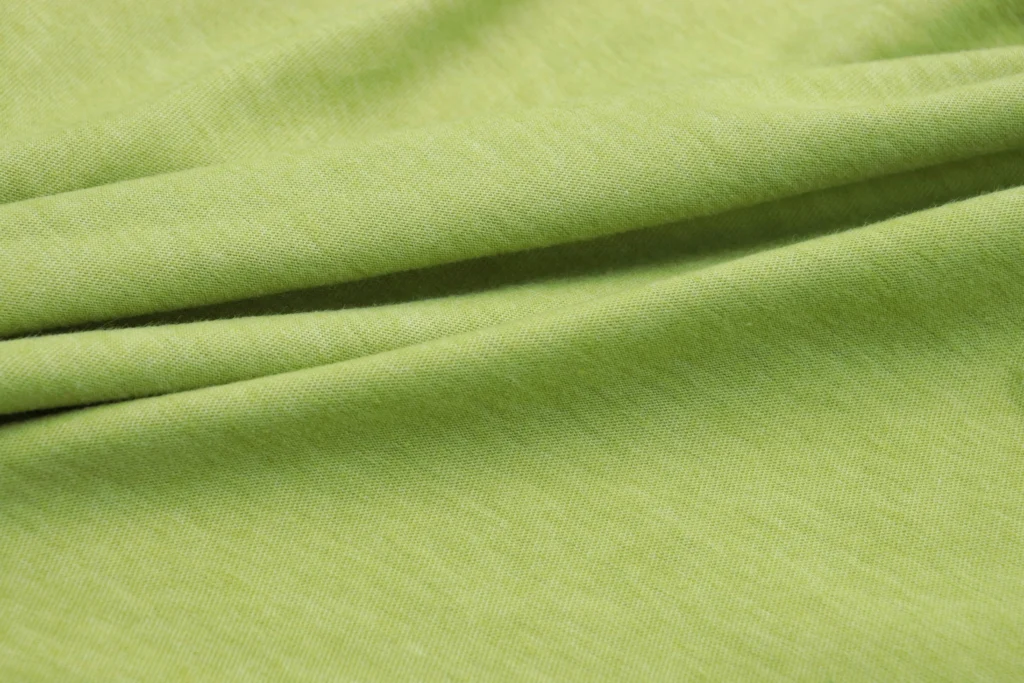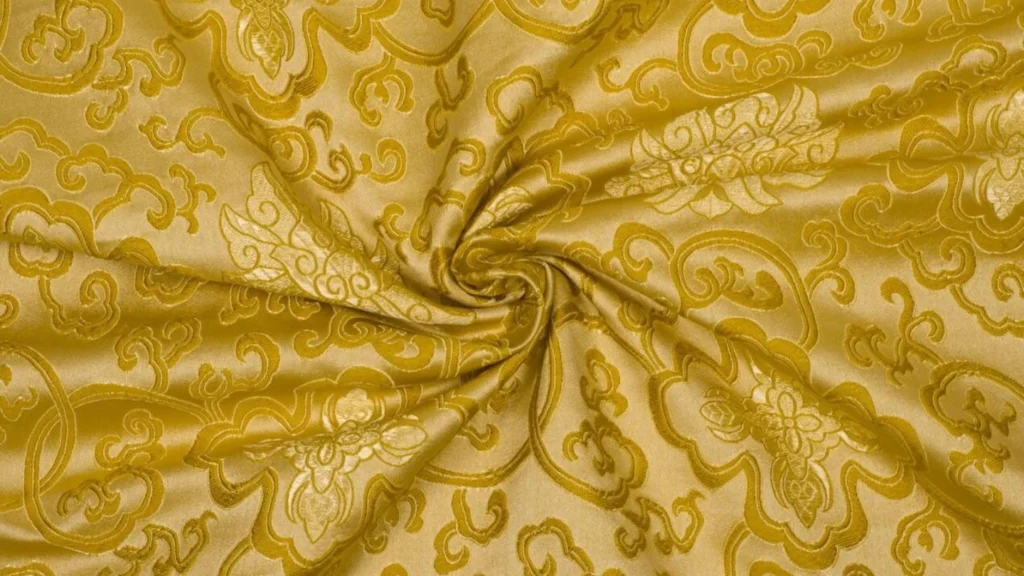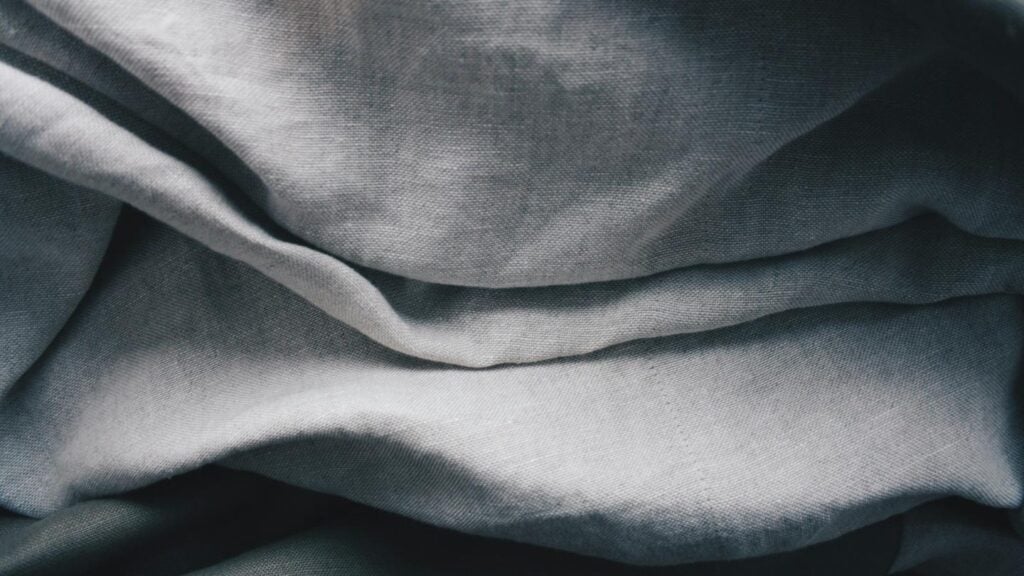2 – Benefits of Choosing Wool
3 – Wool vs Other Fabrics
4 – How Wool Is Manufactured
5 – Common Uses in Fashion
6 – Understanding the Environmental Impact of Wool
7 – Exploring Price Points and Value for Money
8 – Conclusion
9 – FAQs
What is Wool?
Wool is a natural fiber that comes from the fleece of sheep and other animals, including alpacas, goats (producing cashmere and mohair), and rabbits (producing angora). It has been used by humans for thousands of years, primarily for its insulating and moisture-wicking properties. The fiber is made up of keratin, a protein also found in human hair, which gives wool its unique texture and resilience. Wool is highly prized for its ability to regulate body temperature, making it an excellent choice for clothing in both cold and warm conditions. It is soft, flexible, and durable, offering a variety of benefits that other fibers simply cannot match. Wool is also biodegradable and renewable, as sheep can be shorn annually, making it a sustainable choice in fashion and textiles.
Wool comes in various grades and types depending on the animal from which it is sourced and the way it is processed. Fine wool, such as merino, is soft and lightweight, ideal for luxury garments, while coarser wool is often used in outerwear and carpets. Wool’s versatility in fabric construction, such as woven, knitted, and felted, makes it suitable for a wide range of clothing, from cozy sweaters to formal suits.

Benefits of Choosing Wool
Wool offers numerous advantages that make it a preferred choice for clothing and textiles. Some of the key benefits include:
- Natural Insulation: Wool is an excellent insulator, helping to keep you warm in cold temperatures and cool in warmer conditions. This is due to the unique structure of wool fibers, which trap air and provide a natural temperature-regulating effect.
- Moisture-Wicking: Wool can absorb moisture (up to 30% of its weight) without feeling wet, making it an ideal choice for active wear or outerwear. It helps to wick moisture away from the body, keeping you dry and comfortable, even during physical activity.
- Breathability: Unlike synthetic fibers, wool allows air to circulate freely, reducing the risk of overheating. This makes wool fabrics breathable and comfortable for long wear.
- Odor Resistance: Wool naturally resists odors. The structure of wool fibers allows them to absorb and release moisture without holding onto odors, making it perfect for garments worn over long periods.
- Durability and Resilience: Wool is a strong fiber that resists wear and tear. It can maintain its shape and appearance over time, even after repeated use and washing, making it a long-lasting investment.
- Biodegradable and Sustainable: Wool is a renewable resource, as sheep can be shorn annually. It is also biodegradable, meaning it won’t contribute to landfill waste, unlike synthetic fabrics.
- Soft and Comfortable: Modern wool, especially high-quality varieties like merino, is incredibly soft and comfortable against the skin. It doesn’t itch as much as some older wool types, making it more accessible for a wider range of consumers.
- Flame Retardant: Wool is naturally flame-resistant, offering added safety compared to many synthetic fabrics, which can melt when exposed to heat.
- UV Protection: Wool has the natural ability to block harmful UV rays, providing some level of sun protection when wearing woolen garments.

Wool vs Other Fabrics
When compared to other fabrics, wool stands out due to its unique natural properties that offer both performance and sustainability. Here’s a look at how wool compares with some of the most common fabrics:
- Wool vs Cotton: Wool is warmer and more insulating than cotton, making it ideal for colder climates. Cotton, however, is more breathable and lighter, making it better for warm weather.
- Wool vs Polyester: Wool is breathable, moisture-wicking, and biodegradable, while polyester is synthetic, less breathable, and contributes to plastic waste. Wool also provides better insulation.
- Wool vs Silk: Wool is much warmer and more durable than silk, which is more delicate and better for warmer climates. Silk feels luxurious but can’t match wool’s resilience and warmth.
- Wool vs Alpaca Wool: Alpaca wool is softer, lighter, and warmer than traditional wool, making it ideal for luxury items. Wool, though heavier, provides greater insulation for colder conditions.
- Wool vs Camel Wool: Camel wool is lighter and provides excellent insulation, with a softer feel compared to regular wool. Wool is bulkier but better for extremely cold temperatures.
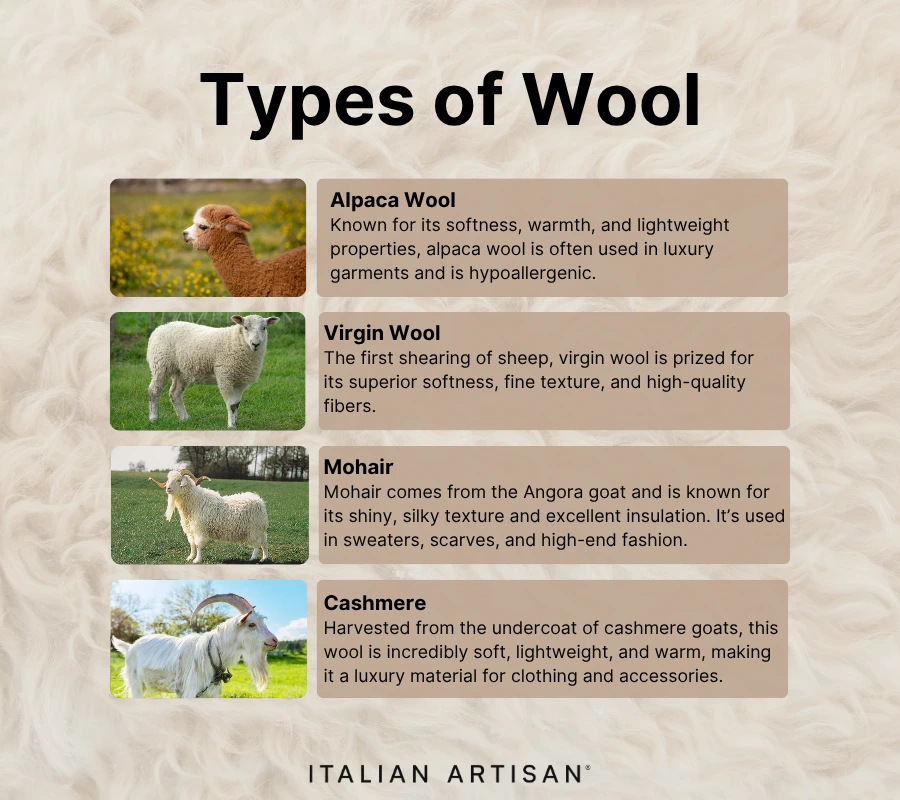
How Wool Is Manufactured
The process of turning raw wool into fabric involves several key stages, each transforming the wool into a versatile material ready for use in garments and textiles.
- Shearing: Sheep (or other wool-producing animals) are carefully sheared to collect their fleece, typically once a year.
- Scouring: The raw wool is washed to remove dirt, grease (lanolin), and any impurities. This is an important step to ensure the wool is clean and ready for further processing.
- Carding: The wool fibers are separated and aligned using a carding machine. This process creates a continuous web of fibers, ready to be spun.
- Spinning: The carded wool is spun into yarn by twisting the fibers together. The thickness and texture of the yarn can vary based on the desired fabric.
- Weaving or Knitting: The spun yarn is either woven or knitted to create fabric. Weaving results in a strong, durable fabric, while knitting creates a stretchier, more flexible material.
- Dyeing: The fabric is dyed to the desired color, either before or after weaving/knitting. Dyeing can be done using natural or synthetic dyes.
- Finishing: The fabric is treated to improve its texture, softness, and durability. Finishing processes may include fulling (shrinking), water-resistant treatments, or adding a smooth finish.

Produce your fashion collection with us
Common Uses in Fashion
Wool is one of the most versatile and widely used fibers in fashion, valued for its natural properties, durability, and aesthetic appeal. Its adaptability across different types of clothing and textiles makes it a staple in both everyday wear and luxury fashion. Here are some of the most common uses of wool in fashion:
- Outerwear: Wool is commonly used in coats, jackets, and suits, where insulation and durability are key.
- Sweaters and Knitwear: Wool is a favorite for knitwear, offering comfort and warmth without being overly heavy.
- Scarves and Hats: Wool scarves, hats, and gloves are essential accessories for cold climates, providing both warmth and style.
- Socks: Wool socks are popular for their moisture-wicking and insulating properties, ideal for outdoor activities.

Understanding the Environmental Impact of Wool
Wool, while a natural and biodegradable fiber, has an environmental footprint that varies depending on the farming practices, processing methods, and product lifecycle. Understanding these factors is important for consumers who want to make informed, eco-conscious choices. Here are the key environmental considerations associated with wool production:
- Water and Land Use: Sheep farming requires significant water and land. Overgrazing can lead to soil erosion, especially in poorly managed areas.
- Methane Emissions: Like other livestock, sheep produce methane, a greenhouse gas. However, wool farming generally has a lower carbon footprint than synthetic fiber production.
- Chemical Use: Traditional wool farming may involve pesticides and chemicals, impacting the environment. Sustainable wool practices, like organic wool, avoid synthetic chemicals, reducing this impact.
- Biodegradability: Wool is naturally biodegradable, unlike synthetic fibers, making it an eco-friendly choice at the end of its life cycle.
- Recycling: Wool can be recycled into new products, contributing to a circular economy and reducing waste.

Exploring Price Points and Value for Money
Wool products can vary significantly in price depending on several factors, including the quality of the wool, production methods, and brand positioning. Understanding these price differences helps consumers make informed choices and determine the best value for their needs.
- Budget Wool
Mass-produced wool items, often made from blends of wool with synthetic fibers, are typically more affordable. These products may not have the same level of durability, softness, or insulating properties as higher-end wool but can still offer good value for everyday wear. Budget wool is often found in fast fashion collections and basic outerwear. - Mid-Range Wool
Mid-range wool products strike a balance between quality and affordability. These garments often use higher-quality wool, such as Merino or other fine wool varieties, and are produced with better techniques. The price reflects the quality of the wool, its durability, and the care taken in the manufacturing process. Mid-range wool is often used in everyday fashion like sweaters, blazers, and suits. - Premium Wool
Premium wool, including Virgin Wool (from the first shearing) and luxury varieties like Cashmere and Alpaca, comes with a higher price tag. These wool types are prized for their softness, warmth, and unique qualities. They are often sustainably sourced, with ethical farming practices adding to their cost. Premium wool garments are a long-term investment, offering superior comfort and durability. They’re commonly found in high-end fashion collections or luxury winter wear. - Sustainably Sourced Wool
Wool produced through sustainable practices, such as organic wool farming, may be priced higher due to the more environmentally friendly methods used. These methods prioritize animal welfare, soil health, and reduced use of chemicals. While the cost is higher, it adds value by supporting ethical practices and reducing the environmental footprint. - Long-Term Value
While higher-quality wool may have a higher upfront cost, it often offers greater long-term value. Wool’s durability, natural elasticity, and resistance to odor mean that wool garments can last longer, reducing the need for replacements. Additionally, wool garments require less frequent washing, which helps maintain their condition and extends their lifespan.
Conclusion
Wool is a timeless and versatile fabric, prized for its natural properties, durability, and sustainability. From its ability to regulate temperature to its breathability and moisture-wicking qualities, wool provides unmatched comfort and performance. While its price may vary depending on factors like type, processing, and brand, wool’s long-lasting nature and eco-friendly benefits make it a valuable investment. Whether for luxury garments, everyday wear, or activewear, wool’s unique combination of durability, versatility, and environmental benefits ensures it remains a top choice for those seeking quality and sustainability in their wardrobe.
FAQs
- What is wool made from? Wool is made from the fleece of sheep and other animals like goats (cashmere and mohair), alpacas, and rabbits (angora). It is composed primarily of keratin, a protein also found in human hair.
- Is wool eco-friendly? Yes, wool is a natural, renewable, and biodegradable material. It is environmentally friendly when sourced responsibly and processed sustainably, making it a great choice for eco-conscious consumers.
- How does wool keep you warm? Wool has natural insulating properties. Its fibers trap air, helping to regulate body temperature by keeping you warm in cold weather and cool in warmer temperatures.
- Does wool require special care? Wool can be delicate, so it’s often recommended to hand wash or dry clean wool garments. Some wool fabrics, like merino, are machine washable, but it’s important to check care labels for specific instructions.
- What is merino wool? Merino wool is a finer, softer type of wool sourced from Merino sheep. It is highly prized for its softness, breathability, and moisture-wicking properties, making it ideal for luxury garments and activewear.
- Can wool shrink? Yes, wool can shrink if exposed to hot water or agitation during washing. To prevent this, wool should be washed gently in cool water and air-dried.
- Is wool hypoallergenic? While wool is naturally resistant to dust mites and other allergens, some people may find it irritating to the skin. Merino wool, known for its finer fibers, is less likely to cause itching compared to coarser wool types.
- How is wool processed? Wool is first sheared from sheep, then cleaned (scoured) to remove grease, dirt, and impurities. The fibers are carded, spun into yarn, and then woven or knitted into fabric. Dyeing and finishing processes may follow to create the final product.
- Why is wool more expensive than synthetic fibers? Wool is a natural, labor-intensive material, and its processing requires more time and care. Additionally, high-quality wool, such as merino or organic wool, costs more due to its superior properties and ethical sourcing.
- Can wool be worn in hot weather? Yes, wool is breathable and moisture-wicking, which helps keep you cool in warm weather. Lightweight wool fabrics, like merino, are great for summer wear and regulate body temperature naturally.

